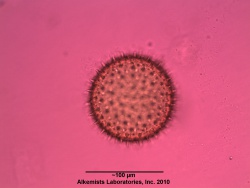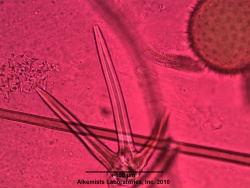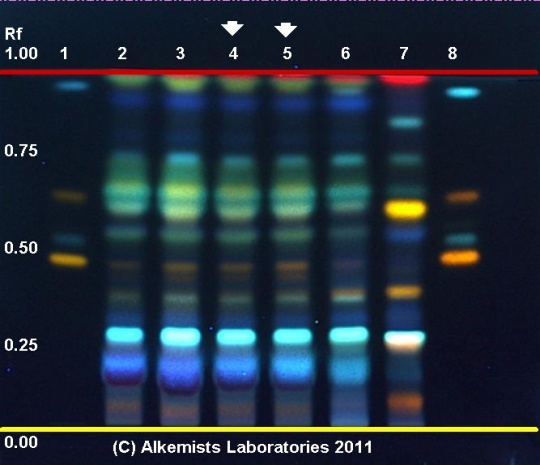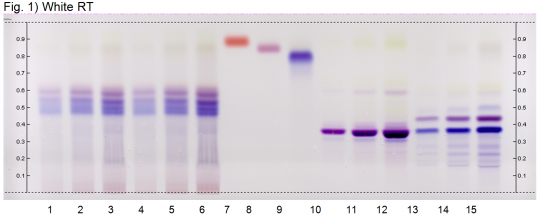Malva sylvestris (flower)
(Nomenclature updated) |
m |
||
| Line 16: | Line 16: | ||
=Organoleptic Characteristics= | =Organoleptic Characteristics= | ||
| − | =Macroscopic | + | =Macroscopic Characteristics= |
Revision as of 01:33, 16 March 2014
Contents |
Nomenclature
Malus sylvestris Mill. Rosaceae
Syn. Pyrus malus L.
Standardized common name (English): crab apple
Botanical Voucher Specimen
Organoleptic Characteristics
Macroscopic Characteristics
Microscopic Characteristics
|
High Performance Thin Layer Chromatographic Identification
|
High Mallow (flower) (Malva sylvestris) Lane Assignments Lanes, from left to right (Track, Volume, Sample):
Reference materials used here have been authenticated by macroscopic, microscopic &/or TLC studies according to the reference source cited below held at Alkemists Pharmaceuticals, Costa Mesa, CA. Stationary Phase Silica gel 60, F254, 10 x 10 cm HPTLC plates Mobile Phase ethyl acetate: HCOOH: AcCOOH: H2O [10/1.1/1.1/2.4] Sample Preparation Method 0.3 g + 3 ml 70% grain EtOH sonicate/heat @ 50° C ~ 1/2 hr Detection Method Natural Product Reagent + PEG -> UV 365 nm Reference see Adapted from British Pharmacopoeia, 2003
|
|
Mallow (flower) (Malva sylvestris) Lane Assignments Lanes, from left to right (Track, Volume, Sample):
Reference Sample(s) Reference: Dissolve 2 mg of pelargonin in 5 mL of methanol. Dissolve 2 mg of delphinidin in 5 mL of methanol; Optional: dissolve 2 mg of malvidin in 5 mL of methanol. Stationary Phase Stationary phase, i.e. Silica gel 60, F254 Mobile Phase 1-Butanol, formic acid, water 65:16:19 (v/v/v) Sample Preparation Method Sample: Mix 1 g of powdered sample with 10 mL of methanol and sonicate for 10 minutes, then centrifuge or filter the solutions and use the supernatants / filtrates as test solutions. Detection Method Saturated chamber; developing distance 70 mm from lower edge; relative humidity 33% Other Notes Images presented in this entry are examples and are not intended to be used as basis for setting specifications for quality control purposes. System suitability test: Pelargonin: red to orange zone at Rf ~ 0.89; Delphinidin: violet zone at Rf ~ 0.80 Identification: Compare result with reference images. The fingerprint of the test solution is similar to that of the corresponding botanical reference sample. Additional weak zones may be present. The chromatogram of the test solution shows one intensive violet zone at Rf ~ 0.35. Test for other species: No intense violet-blue zones are seen between Rf ~ 0.46 and 0.55 (Bilberry fruit) and no violet zone is present at Rf ~ 0.44 (Roselle flower).
|
Supplementary Information
Sources
- ↑ Elan M. Sudberg, Alkemist Laboratories http://www.alkemist.com
- ↑ Elan M. Sudberg, Alkemist Laboratories http://www.alkemist.com
- ↑ Elan M. Sudberg, Alkemist Laboratories http://www.alkemist.com
- ↑ Elan M. Sudberg, Alkemist Laboratories http://www.alkemist.com
- ↑ HPTLC Association http://www.hptlc-association.org/





